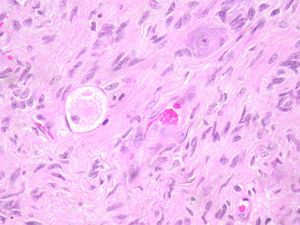Key-Gaskell Syndrome
Jump to navigation
Jump to search
- Autonomic polyganglioneuropathy in cats
- Abnormal function of the sympathetic and parasympathetic system.
- Whole autonomic system involved – affected animals usually die.
- Similar to grass sickness in horses.
Clinical
- Cats show:
- Megaoesophagus
- Dilated pupils
- Whole gut is involved (very little peristalsis)
- Constipation.
- Generalised autonomic effects:
- Reduced salivation
- Reduced lachrymation
- Bradycardia
- Constipation
- Pupillary dilatation
Pathology
- Histologically there is marked reduction in the number of neurones in all autonomic ganglia in the ventral horn of all levels of spinal cord accompanied by proliferation of non-neuronal cells.
- Similar changes in brain stem nuclei of cranial nerves.
Pathogenesis
- Acquired disease - outbreaks occurred in the past, now only occasionally seen but seems to be getting more common again.
- Possibly toxic cause.
- Possibly in dry food or in vaccine?
- Agent not really known, but produces general damage to autonomic nervous system.
Feline dysautonomia, or Key-Gaskell Syndrome
- Occurs mostly in the UK and continental Europe.
- Is also of unknown aetiology. Suggested causative factors include:
- Environmental toxins
- Infectious agents
- Botulinum toxins .
- Clinical signs:
- Anorexia
- Depression
- Bradycardia
- Decreased lacrimation,
- Altered pupillary dilataion,
- Megaoesophagus
- Constipation.
- Degenerative lesions of autonomic nerve ganglia can be seen.
- Also occurs in the oesophagus.
